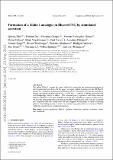Formation of a Malin 1 analogue in IllustrisTNG by stimulated accretion
Author(s)
Zhu, Qirong; Xu, Dandan; Gaspari, Massimo; Rodriguez-Gomez, Vicente; Nelson, Dylan; Vogelsberger, Mark; Torrey, Paul; Pillepich, Annalisa; Zjupa, Jolanta; Weinberger, Rainer; Marinacci, Federico; Pakmor, Rüdiger; Genel, Shy; Li, Yuexing; Springel, Volker; Hernquist, Lars; ... Show more Show less
DownloadAccepted version (844.6Kb)
Terms of use
Metadata
Show full item recordAbstract
© 2018 The Author(s). The galaxy Malin 1 contains the largest stellar disc known but the formation mechanism of this structure has been elusive. In this paper, we report a Malin 1 analogue in the 100 Mpc IllustrisTNG simulation and describe its formation history. At redshift zero, this massive galaxy, having a maximum circular velocity Vmax of 430 km s-1, contains a 100 kpc gas/stellar disc with morphology similar toMalin 1. The simulated galaxy reproduces well many observed features of Malin 1's vast disc, including its stellar ages, metallicities, and gas rotation curve. We trace the extended disc back in time and find that a large fraction of the cold gas at redshift zero originated from the cooling of hot halo gas, triggered by the merger of a pair of intruding galaxies. Our finding provides a novel way to form large galaxy discs as extreme as Malin 1 within the current galaxy formation framework.
Date issued
2018Department
Massachusetts Institute of Technology. Department of Physics; MIT Kavli Institute for Astrophysics and Space ResearchJournal
Monthly Notices of the Royal Astronomical Society: Letters
Publisher
Oxford University Press (OUP)